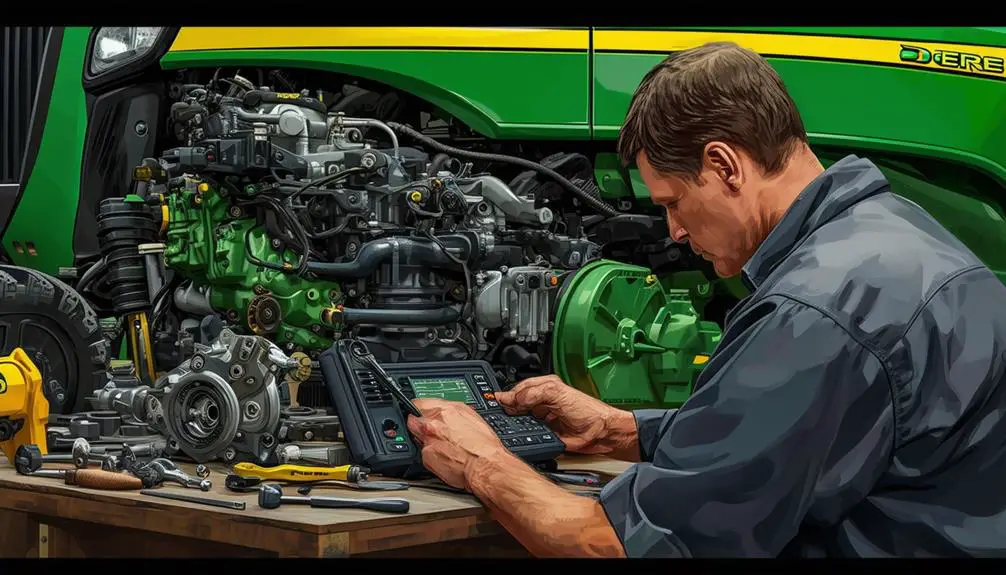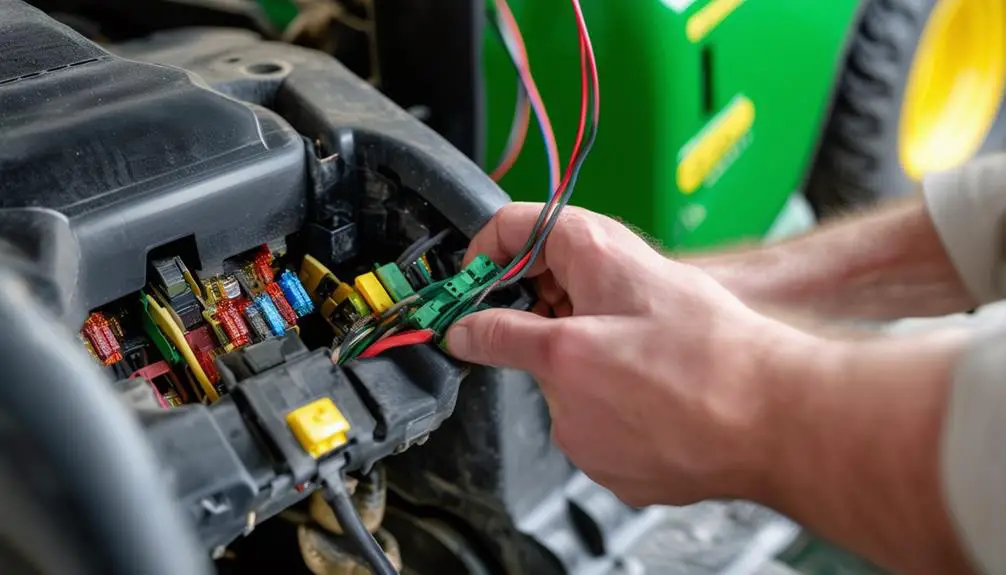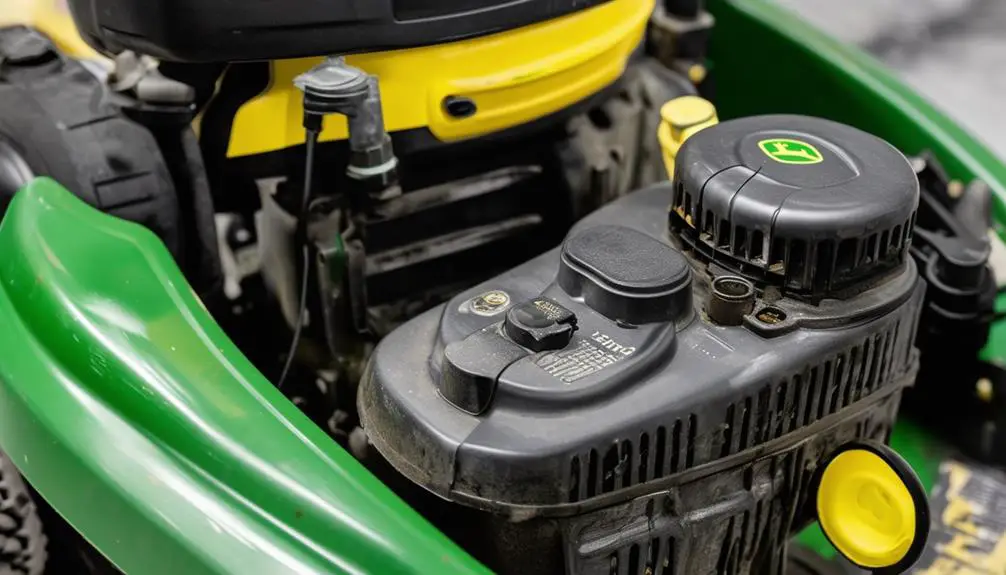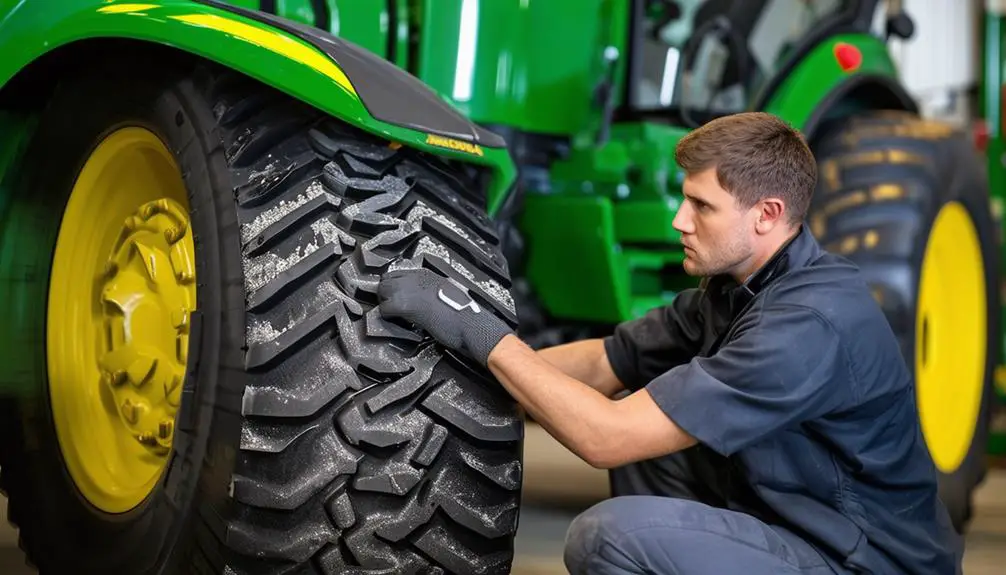If you're facing common issues with your John Deere S120, did you know that implementing the right solutions can increase its efficiency by up to 30%? From engine troubleshooting to tire care and replacement, there are seven key strategies to optimize your mower's performance. By following these expert tips, you can guarantee your John Deere S120 operates smoothly and efficiently, saving you time and potential headaches down the road.
Things to Note
- Check fuel filter for clogs to ensure proper fuel flow.
- Verify spark plug condition and gap for efficient starting.
- Maintain blade sharpness and balance to prevent vibrations.
- Address transmission leaks promptly to avoid damage.
- Monitor tire pressure and wear for optimal performance.
Engine Troubleshooting

If your John Deere S120 is experiencing engine issues, start by checking the fuel filter for any clogs or debris. A clogged fuel filter can restrict the flow of fuel to the engine, causing it to run poorly or not start at all.
Freeing your engine from this simple issue can have a significant impact on its performance.
To further empower your troubleshooting efforts, verify that the spark plug is clean and properly gapped. A dirty or faulty spark plug can lead to issues with starting and running smoothly.
Embrace the freedom of taking control of these basic maintenance tasks to keep your John Deere S120 running smoothly and efficiently.
Steering Adjustment
When it comes to steering adjustment on your John Deere S120, there are a few key points to keep in mind.
Maintain proper wheel alignment to maintain control and stability.
Checking tire pressure and calibrating the steering wheel are also essential for smooth operation.
Proper Wheel Alignment
Adjust the steering of your John Deere S120 to make sure it is properly aligned for peak performance. Proper wheel alignment is important for best handling and tire wear. If you notice your mower veering to one side or the steering wheel not being centered when driving straight, it's time to align your wheels. Here's a simple guide to help you adjust the wheel alignment of your John Deere S120:
| Steps to Proper Wheel Alignment | |
|---|---|
| 1. Park on a Level Surface | Ensure your mower is on a flat surface to get an accurate alignment reading. |
| 2. Adjust the Tie Rods | Use a wrench to loosen the tie rod ends and adjust them until the wheels are straight. |
| 3. Test Drive and Fine-Tune | Take your mower for a test drive to check if the alignment is correct. Make further adjustments if necessary. |
Checking Tire Pressure
To maximize steering performance on your John Deere S120, regularly check and adjust the tire pressure as needed. Proper tire pressure is essential for ensuring best possible traction, stability, and overall control of your mower.
Incorrect tire pressure can lead to uneven wear, reduced maneuverability, and potential safety hazards during operation. Start by checking the manufacturer's recommendations for the ideal tire pressure range for your specific John Deere S120 model.
Using a tire pressure gauge, measure the current pressure in each tire and add or release air as necessary to meet the recommended levels. Make sure to check the pressure when the tires are cold for the most accurate readings.
Steering Wheel Calibration
Maximize steering performance on your John Deere S120 by calibrating the steering wheel for precise control and maneuverability. To begin the steering wheel calibration process, make sure your tractor is on a flat, level surface with the engine off.
Start by turning the steering wheel fully to the left until it stops, then slowly bring it back to the center position. Next, turn the wheel fully to the right and return it to the center again. Repeat this process a few times to allow the system to adjust.
After completing these steps, turn on the engine and test the steering wheel to confirm if it now responds accurately to your movements. If adjustments are needed, repeat the calibration process until you achieve the desired responsiveness.
Proper steering wheel calibration not only enhances your driving experience but also promotes safety by ensuring precise control over your John Deere S120. Take control of your steering performance by calibrating your steering wheel for best results.
Electrical System Fixes

For resolving electrical issues on your John Deere S120, start by checking the battery connections for any signs of corrosion. Corrosion can impede the flow of electricity, leading to a range of problems with your mower's electrical system. Freeing your mower from these issues is simple – all you need is a wire brush to clean off any corrosion.
Next, inspect the wiring harness for any visible damage or wear. Freedom from electrical woes often starts with a thorough visual inspection.
If you're still facing glitches after checking the battery and wiring harness, consider examining the fuses. Sometimes a blown fuse can be the culprit behind electrical malfunctions. Replacing a blown fuse is a quick and straightforward way to reclaim your mower's electrical vitality.
Blade Maintenance Tips
Wondering how to keep your John Deere S120's blades in top condition for peak performance? To guarantee your mower is always ready to tackle the toughest grass, follow these liberating blade maintenance tips.
Regularly inspect the blades for any signs of wear, such as dullness or nicks. Sharpen the blades at least once a season, or more frequently if you notice decreased cutting efficiency. It's essential to balance the blades after sharpening to prevent vibrations that could damage your mower.
When mowing, avoid hitting rocks, stumps, or other hard objects that can cause the blades to bend or become misaligned. Cleaning the blades after each use will prevent grass clippings from building up and causing rust. Additionally, keep an eye on the blade's tightness and alignment to make sure they're securely attached to the mower deck.
Fuel System Solutions

To keep your John Deere S120 running smoothly, make sure to regularly maintain the fuel filter, store fuel properly, and clean the fuel injectors.
Neglecting these key fuel system maintenance tasks can lead to performance issues and costly repairs down the line.
Fuel Filter Maintenance
Check you regularly examine and substitute the fuel filter in your John Deere S120 to sustain peak fuel system performance. The fuel filter plays an essential role in maintaining that only clean fuel reaches the engine, preventing contaminants from causing damage. Regular maintenance of the fuel filter can help avoid issues such as clogs and poor engine performance. Here are some quick tips to guide you through fuel filter maintenance for your John Deere S120:
| Fuel Filter Maintenance Tips | Description |
|---|---|
| Inspect Regularly | Check the fuel filter for any signs of blockage or dirt accumulation. |
| Replace Timely | Replace the fuel filter according to the manufacturer's recommended schedule. |
| Use Quality Filters | Ensure you use high-grade fuel filters to maintain peak performance. |
| Monitor Fuel Quality | Keep an eye on the fuel quality to prevent premature clogging of the filter. |
| Professional Service | When in doubt, seek professional assistance for fuel filter replacement. |
Proper Fuel Storage
Regularly storing fuel properly is vital for maintaining the overall health and efficiency of your John Deere S120's fuel system. When it comes to ensuring your equipment runs smoothly, taking care of your fuel storage is important.
Here are some key tips to help you keep your fuel in top condition:
- Use airtight containers: Store your fuel in sealed containers to prevent contamination and evaporation.
- Keep fuel away from direct sunlight: Sunlight exposure can cause fuel to degrade faster, so store it in a cool, dark place.
- Use fuel stabilizers: Adding stabilizers to your fuel can help prolong its shelf life and prevent it from breaking down over time.
Fuel Injector Cleaning
Properly maintaining your John Deere S120's fuel injectors is essential for peak performance and efficiency. Over time, fuel injectors can get clogged with dirt, debris, and carbon buildup, leading to issues like poor fuel economy, rough idling, and decreased power. To keep your S120 running smoothly, regular fuel injector cleaning is crucial.
One liberating solution is using a high-quality fuel injector cleaner. Adding a cleaner to your fuel tank during fill-ups can help break down deposits and prevent buildup, keeping your fuel system clean and efficient.
Another option is professional fuel injector cleaning services, where specialized equipment is used to thoroughly clean injectors and restore optimal performance.
Make sure to follow the manufacturer's recommendations for cleaning intervals and products suitable for your John Deere S120. By maintaining clean fuel injectors, you can enjoy improved engine performance, better fuel efficiency, and overall longevity of your equipment.
Keep your S120 running strong by giving your fuel injectors the care and attention they deserve.
Transmission Problem Solving
To effectively address transmission problems with your John Deere S120, understanding common issues and their solutions is crucial. Here are some tips to help you troubleshoot and resolve transmission issues:
- Check Fluid Levels: Verify that the transmission fluid is at the proper level. Low fluid levels can lead to poor transmission performance.
- Inspect for Leaks: Look for any signs of leaks around the transmission system. Leaks can cause fluid loss and result in transmission malfunctions.
- Monitor Transmission Behavior: Pay attention to any unusual sounds, vibrations, or delays in gear shifting. These could be indicators of underlying transmission problems that need to be addressed promptly.
Tire Care and Replacement

Inspecting your John Deere S120's tires regularly is vital for maintaining peak performance and longevity. Proper tire care starts with checking the tire pressure, meeting the manufacturer's recommendations. Underinflated tires can lead to poor traction and uneven wear, while overinflated tires can cause a harsh ride and potential damage.
Additionally, inspect the tires for any signs of wear, cuts, or punctures. Replace tires that show excessive wear or damage to maintain peak performance.
When it comes to replacing tires, make sure to choose the correct size and type recommended for your John Deere S120. Installing incorrect tires can affect the machine's handling and overall performance. Consider factors like the terrain you'll be operating on and the type of work you'll be doing to select the most suitable tires.
Regularly rotating your tires can also help promote even wear and extend their lifespan. By keeping your John Deere S120's tires in top condition, you'll ensure smooth operation and maximize efficiency during your tasks.
Frequently Asked Questions
How Can I Improve the Overall Performance of My John Deere S120?
To boost your John Deere S120's performance, start by regular maintenance checks like changing oil and filters.
Upgrade air filters for better airflow while ensuring proper tire pressure for traction.
Adjust mower deck levels and sharpen blades for efficient cutting.
Consider adding fuel additives for engine health and power.
Are There Any Recommended Accessories or Attachments for the John Deere S120?
You can definitely enhance your John Deere S120 with a range of recommended accessories and attachments. Consider options like a bagger attachment for efficient grass collection, a mulching kit for improved lawn health, or a snow blade for winter versatility.
These additions can elevate the functionality of your S120, making it a more versatile and efficient tool for your lawn care needs.
What Is the Average Lifespan of a John Deere S120 Mower?
The average lifespan of a John Deere S120 mower typically ranges between 10 to 15 years with proper maintenance and care.
Regular servicing, cleaning, and storage can help extend its longevity. Remember to follow the manufacturer's guidelines for maintenance schedules and procedures.
How Can I Protect My John Deere S120 From Extreme Weather Conditions?
To protect your John Deere S120 from extreme weather conditions, store it in a covered area when not in use.
Regularly check for any signs of damage caused by weather exposure.
Consider investing in a weather-resistant cover to shield your mower from rain, snow, or excessive sunlight.
Keep the mower clean and dry to prevent rust and other weather-related issues.
Taking these precautions can help extend the lifespan of your equipment.
Are There Any Specific Storage Tips for the John Deere S120 During the Off-Season?
During the off-season, remember to store your John Deere S120 properly. Keep it in a dry, covered area to shield it from the elements.
Before storing, clean the equipment thoroughly and perform any necessary maintenance tasks. Check the oil levels and make sure the fuel tank is empty or treated with a stabilizer.
Conclusion
So, don't let your John Deere S120 run on empty! Keep its engine purring like a contented cat, its blades slicing through grass like a hot knife through butter, and its tires rolling smoothly like a well-oiled machine.
By implementing these quality solutions, you'll guarantee your mower stays in excellent condition and ready to tackle any lawn care challenge that comes its way.
Happy mowing!